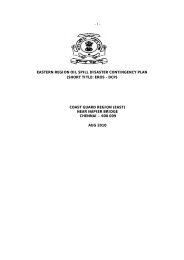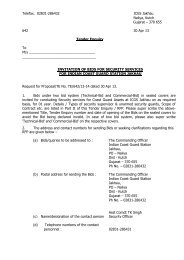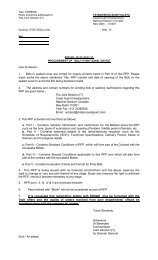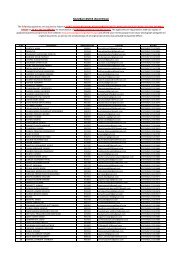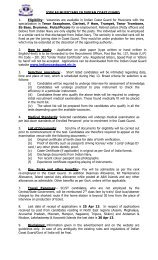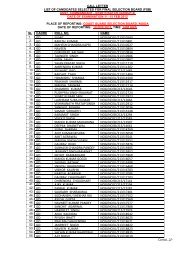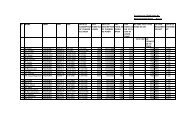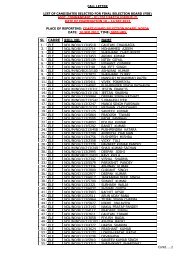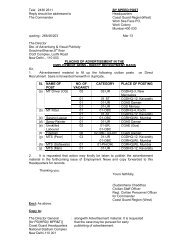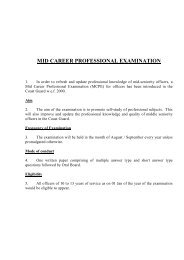ICGSMA Bulletin - Indian Coast Guard
ICGSMA Bulletin - Indian Coast Guard
ICGSMA Bulletin - Indian Coast Guard
Create successful ePaper yourself
Turn your PDF publications into a flip-book with our unique Google optimized e-Paper software.
QUARTERLY MARCH 2013<br />
VOL -3<br />
ISSUE-11<br />
An insight to trouble shooters
<strong>ICGSMA</strong><br />
BULLETIN<br />
Aims<br />
to provide a forum<br />
for communication on<br />
technical issues relevant<br />
to the ships operation<br />
An insight to trouble shooters
<strong>ICGSMA</strong> BULLETIN (JAN - MAR 13)<br />
Contents<br />
Technology Savvy<br />
1 Sustaining Expertise to Address<br />
onboard maintenance of Modernised<br />
Equipment<br />
3 Super Cavitation<br />
6 Use of Magnetic Pick up<br />
Technical Experience<br />
– Case Studies<br />
7 Defect Rectification on STBD Main<br />
Engine Control of ICGS Annie Besant<br />
8 Repair of Main Engine<br />
Exhaust Overboard Pipe<br />
10 Defect Rectification on Idle RPM<br />
on DA<br />
CENTER COLUMN “Common<br />
Paint Defect and Remedies” - Article<br />
covers the problems which occur after the<br />
painting--- C-153<br />
SUSTAINING EXPERTISE TO ADDRESS<br />
ONBOARD MAINTENANCE OF<br />
MODERNISED EQUIPEMENT<br />
Commander VR Maharshi<br />
ICGS Samrat<br />
1. The AOPV and PCV class of ship’s has<br />
specialized equipment like integrated Bridge<br />
system (IBS), integrated Automatic Machinery<br />
Control Systems (IAMCS) and Pollution Control<br />
Systems (PCS). The influx of modernized equipment<br />
has ensured a level of comfort in operations<br />
management and manpower resources. However,<br />
maintenance challenges are expected to increase<br />
in future if logistics management and cadre training<br />
do not simultaneously keep pace with the<br />
induction.<br />
2. There have been three different cases that<br />
have defined the technical challenges to the<br />
maintainers onboard:-<br />
(a) The PME was found to be<br />
declutching in single engine regimes while<br />
doing high RPM. The engine and gear box<br />
parameters were found to be normal. There<br />
were no alarms recorded in the Automatic<br />
Integrated Machinery Control Systems<br />
(AIMCS) panel.<br />
(b) While starting AC, a significant dip<br />
was observed in the ship’s main supply<br />
voltage resulting in Navigation equipment<br />
like Log, Echo sounder and ECDIS switching<br />
off. A sudden dip in voltage is observed<br />
when heavy machinery is switched on with<br />
direct online starters or even auto<br />
transformer starters. This should not have<br />
been the case as the associated soft starter<br />
should have ensured a smooth starting<br />
cycle. The logical diagnosis pointed towards<br />
a defective controller PCB that controls the<br />
firing cycle of thyristors in the starting cycle.<br />
An insight to trouble shooters 1
<strong>ICGSMA</strong> BULLETIN (JAN - MAR 13)<br />
The thyristors themselves were found good.<br />
However, while the ship has changed the<br />
controller PCB and the three thyristors in<br />
the starting circuit (as a precautionary<br />
measure), the AC continues to trip after the<br />
starting cycle is complete. AC is presently<br />
being exploited in Direct Online starter<br />
mode pending further analysis of defect on<br />
soft starter by the OEM.<br />
(c) The stabiliser of the ship has a<br />
unique problem, its port stabiliser does not<br />
start from local position and the<br />
starboard stabiliser does not start from<br />
remote location. Once started the<br />
system performance is more than<br />
satisfactory.<br />
3. To give credit to our training<br />
methodologies, I do find that the average<br />
Yantrik /Navik after his basic training is<br />
reasonably equipped to arrive at the least<br />
denominator of maintenance on the<br />
sophisticated equipment being inducted.<br />
What I mean by the least denominator of<br />
training is the level to which he himself can<br />
apply methods taught to him at school. But, I<br />
will add a caveat here that the comfort that<br />
every maintainer settles into of being super<br />
operator/reset maintainer has to be avoided<br />
as also the urge to strait jacket every defect<br />
into the parameters of a previous defect<br />
experience.<br />
sometimes fail to explain what role each<br />
component in the sub system is performing.<br />
Secondly, circuit descriptions are not provided to<br />
explain the logic of implementing a design<br />
philosophy. In such a scenario there is no escape<br />
for continued dependence on OEM based training<br />
on each system prior commissioning of a ship.<br />
But this training has a shelf life. Once the<br />
trained personnel are not associated with the<br />
project or are posted out of the ship after their<br />
tenure resulting in the expertise vanishing with<br />
them. The subsequent commissions suffer from<br />
COMMON PAINT DEFECTS AND REMEDIES<br />
(DO YOU KNOW?)<br />
Many problems can occur after painting. Sometimes,<br />
they occur simultaneously during painting.<br />
Understanding the causes of some of these defects can<br />
make the paint job easier. Here are some common paint<br />
defects and their solutions:<br />
BLISTERING - Blistering or Swelling of paint is caused<br />
due to the trapping of air, moisture or solvent between<br />
the surface and the paint film.<br />
SOLUTION - Remove any unstable paint films and<br />
allow the wall to dry thoroughly. Then repaint with a<br />
recommended paint. Avoid painting under direct<br />
sunlight.<br />
4. The maintainer of a system is capable of<br />
handling the systems only when he knows the<br />
complexity of the system which is not provided<br />
in abinitio training. Basic training is more broad<br />
based and is not system specific. There goes an<br />
argument that the system training can be gleaned<br />
from manuals and documents provided it.<br />
However, there are two issues that have made this<br />
argument unsustainable, firstly the manuals are<br />
not as comprehensive as they used to be and<br />
lack of any exposure to the system and are wholly<br />
dependent on the available documentation which<br />
is not necessarily comprehensive.<br />
5. PRE-COMMISSION TRAINING: In the <strong>Indian</strong> Navy<br />
there is a concept of Pre-Commission Training<br />
An insight to trouble shooters 2
<strong>ICGSMA</strong> BULLETIN (JAN - MAR 13)<br />
(PCT) of<br />
personnel who<br />
are posted to<br />
maintain a group<br />
of complex<br />
systems. This<br />
allows for the<br />
personnel to get<br />
acquainted with<br />
the system and<br />
its<br />
documentation<br />
that they are<br />
going to<br />
maintain. This<br />
training is<br />
conducted in the<br />
training<br />
establishments<br />
which allows for<br />
system experts<br />
to interact with<br />
the future maintainers and share their experiences.<br />
On minor equipment or in case limited expertise<br />
exists, OEM trained personnel are called from the<br />
fleet/their current appointment for giving guest<br />
lectures so that the transfer of technical knowhow<br />
is passed on. So once the Individual is posted<br />
onboard he is better prepared to face the system<br />
complexities. While lack of a dedicated training<br />
school is a hindrance in coast guard, it certainly<br />
does not make the concept of a PCT untenable. A<br />
two week capsule course from an OEM trained<br />
personnel can always be conducted for an<br />
individual EP/Officer who is going to take up a fresh<br />
appointment on modernised ships.<br />
COMMON PAINT DEFECTS AND REMEDIES<br />
(DO YOU KNOW?)<br />
PATCHINESS - Patchiness or uneven finish is caused due to the<br />
highly absorbent nature of the surface.<br />
SOLUTION - Apply an extra coat of primer or use well-sealer.<br />
PEELING - Peeling is caused by moisture on the wall, poor surface<br />
preparation or using an incorrect painting system. This defect<br />
happens on walls as well as wood or metal surfaces.<br />
SOLUTION FOR WALLS - Check and repair water seepage.<br />
Ensure walls are dry before painting. Use an alkali-resistant<br />
basecoat or sealer. Patch surface defects with putty.<br />
SOLUTION FOR WOOD - Prime wood before painting, sand surface<br />
and clean off dust.<br />
SOLUTION FOR METAL - Remove all paint from metal before repainting.<br />
Prime surface and re-coat with suitable paint.<br />
6. CONTINUED TRAINING: A fresh approach to<br />
development of a trained pool of EPs could also be<br />
to institute the concept of continued training<br />
through OEMs. The DRDO’s have always carried<br />
out a Continued Education Programme (CEP) for its<br />
recruits. A CEP can be organised on any of the<br />
modernised equipment through the OEMs every<br />
two years for target audience of fresh EPs<br />
maintaining<br />
modernised<br />
equipment.<br />
This allows for<br />
a refresher<br />
course for the<br />
EPs and also<br />
allows for<br />
sticky problems<br />
to be resolved<br />
through free<br />
and frank<br />
discussions<br />
with trained<br />
technical<br />
personnel from<br />
the firm. In the<br />
absence of a<br />
training<br />
establishment<br />
and PCT this is<br />
a viable<br />
alternative to generate a pool of sailors on the<br />
target equipment.<br />
7. In conclusion, I would like to reiterate the<br />
need to develop and maintain a pool of personnel<br />
trained on modernised equipment so that there is<br />
perpetuation of a healthy maintenance philosophy<br />
and the dependence on OEMs is reduced in the<br />
ICG. The three methods suggested for such an<br />
approach is to conduct PCTs, do cadre<br />
management and/or follow the principles of CEP. I<br />
strongly recommend the CEP approach in the<br />
present scenario.<br />
SUPERCAVITATION<br />
Asst Commandant Arun Chauhan<br />
ICGS Bhikhaiji Cama<br />
INTRODUCTION<br />
SUPERCAVITATION is the use of cavitation<br />
effects to create a bubble of gas inside a liquid<br />
An insight to trouble shooters 3
<strong>ICGSMA</strong> BULLETIN (JAN - MAR 13)<br />
large enough to encompass an object travelling<br />
through the liquid, greatly reducing the skin friction<br />
drag on the object and enabling achievement of<br />
form in a liquid, calculated as the difference<br />
between local pressure and vapour pressure,<br />
divided by dynamic pressure.) Once the flow slows<br />
down again, the water vapour will generally be<br />
reabsorbed into the liquid water. That can be a<br />
problem for ship propellers if cavitation bubbles<br />
implode on the surface of the propeller, each<br />
applying a small force that is concentrated in both<br />
location and time, causing damage.<br />
very high speeds. Current applications are mainly<br />
limited to projectiles or very<br />
fast torpedoes, but in principle<br />
the technique could be<br />
extended to include vehicles.<br />
An object (black)<br />
encounters a liquid (blue) at<br />
high speed. The fluid pressure<br />
behind the object is lowered<br />
below the vapour pressure of<br />
the liquid, forming a bubble of<br />
(a cavity) that vapour<br />
encompasses [[[the object.<br />
PHYSICAL PRINCIPLE<br />
A common occurrence of water vapour<br />
bubbles is observed in a pan of boiling water. In<br />
that case the water pressure is not reduced, but<br />
COMMON PAINT DEFECTS AND REMEDIES<br />
(DO YOU KNOW?)<br />
FLAKING - Flaking-off of paint film is due to improper application of<br />
primer coat over putty, and not being completely covered. It can be due<br />
to application of paint on insufficiently dry surfaces. It can also be due<br />
to shrinkage or expansion of a surface causing the paint film to move.<br />
SOLUTION - Ensure that there are no gaps in covering putty with primer<br />
coat. Also ensure that the surface is dry and clean.<br />
In water, cavitation<br />
occurs when water pressure is<br />
lowered below the water's<br />
vapour pressure, forming<br />
bubbles of vapour. That can<br />
happen when water is<br />
accelerated to high speeds as<br />
when turning a sharp corner around a moving<br />
piece of metal such as a ship's propeller or a<br />
pump's impeller. The greater the water depth (or<br />
pressure for a water pipe) at which the fluid<br />
acceleration occurs, the less the tendency for<br />
cavitation because of the greater difference<br />
between local pressure and vapour pressure. (The<br />
non-dimensional Cavitation number is a measure<br />
of the tendency for vapour pressure bubbles to<br />
rather, the vapour pressure of the water is<br />
increased by means of heating. If the heat<br />
source is sufficient, the bubbles will detach<br />
from the bottom of the pan and rise to the<br />
surface as steam. Otherwise if the pan is removed<br />
from the heat the bubbles will be reabsorbed into<br />
the water as it cools, possibly causing pitting or<br />
spalling on the bottom of the pan as the bubbles<br />
implode.<br />
An insight to trouble shooters 4
<strong>ICGSMA</strong> BULLETIN (JAN - MAR 13)<br />
A supercavitating object is a high speed<br />
submerged object that is designed to initiate a<br />
cavitation bubble at the nose which (either<br />
naturally or<br />
augmented with<br />
internallygenerated<br />
gas)<br />
extends past the<br />
aft end of the<br />
object,<br />
substantially<br />
reducing the skin<br />
friction drag that<br />
would be present<br />
if the sides of the<br />
object were in<br />
contact with the<br />
liquid in which the<br />
object is<br />
submerged. A key<br />
feature of the<br />
supercavitating<br />
object is the nose,<br />
which may be<br />
shaped as a flat<br />
disk or cone and<br />
COMMON PAINT DEFECTS AND REMEDIES<br />
(DO YOU KNOW?)<br />
BITTINESS - Bittiness is caused by dirt from the atmosphere or the<br />
surface or from brushes that are inadequately cleaned or due to<br />
bits of dried-up paint that gets stirred in.<br />
SOLUTION - Use clean brushes and paint on clean surface and<br />
strain the paint through a cloth before use.<br />
ALGAE/FUNGUS GROWTH - Algae and fungus can grow when<br />
the surface is continually damp and dirty. Insufficient fungicide/<br />
algaecide in the paint can also worsen the situation.<br />
SOLUTION - Remove algae / fungus by high-pressure washing.<br />
Wash again to remove any residue and allow the wall to<br />
dry before applying with recommended paint.<br />
BRUSH MARKS - Brush marks are caused due to under-thinning<br />
of paints or due to poor application of the final coat of paint or<br />
due to poor quality brush.<br />
SOLUTION - Ensure paint of the right viscosity is applied using a<br />
good brush.<br />
may<br />
be<br />
articulated, but<br />
which likely has a<br />
sharp edge<br />
around the<br />
perimeter behind which the cavitation bubble<br />
forms. The shape of the object aft of the nose will<br />
generally be slender in order to stay within the<br />
limited diameter of the cavitation bubble. If the<br />
bubble is of insufficient length to encompass the<br />
object, especially at slower speeds, the bubble can<br />
be enlarged and extended by injection of high<br />
pressure gas near the object's nose.<br />
The great speed required for<br />
supercavitation to work can be achieved<br />
temporarily by a projectile fired under water or by<br />
an airborne projectile impacting the water. Rocket<br />
propulsion can be used for sustained operation,<br />
with the possibility of tapping high pressure gas to<br />
route to the object's nose in order to enhance the<br />
cavitation bubble. An example of rocket propulsion<br />
is the Russian<br />
Shkval<br />
multiple nozzles.<br />
supercavitating<br />
torpedo. In<br />
principle,<br />
maneuvering may<br />
be achieved by<br />
various means<br />
such as drag fins<br />
that project<br />
through the<br />
bubble into the<br />
surrounding<br />
liquid, by tilting<br />
the nose of the<br />
object, by<br />
injecting gas<br />
asymmetrically<br />
near the nose in<br />
order to distort<br />
the geometry of<br />
the cavity, by<br />
vectoring rocket<br />
thrust through<br />
gimbaling for a<br />
single nozzle or<br />
by differential<br />
thrust for<br />
APPLICATION<br />
Supercavition can be used in a variety of<br />
marine applications. General application consists of<br />
propellers for high speed torpedoes, propellers for<br />
light vessels specifically designed to carry a small<br />
group of naval crew at high speeds. The major<br />
limitation in implementation of supercavitation on<br />
a large scale basis is that the technology has not<br />
yet been refined so that larger propeller blades can<br />
be used. Also the introduction of water jet<br />
propulsion has provided marine industry with a<br />
simpler and effective mode of propulsion.<br />
An insight to trouble shooters 5
<strong>ICGSMA</strong> BULLETIN (JAN - MAR 13)<br />
INTRODUCTION<br />
USE OF MAGNETIC PICK UP<br />
A Biswas, SE(P)<br />
C-140<br />
Every ignition system requires a trigger<br />
signal to accurately fire and deliver a high voltage<br />
spark from the coil. There are several ways this is<br />
achieved, from mechanical breaker points to<br />
magnetic pickups, optical triggers and other<br />
electronic switches which all serve the same<br />
function; to accurately trigger the ignition at the<br />
correct moment for the ideal spark timing. Now a<br />
days this technique is using in 4 stroke OBM and<br />
RIB engine for better performance<br />
HOW DOES IT WORK?<br />
The magnetic pickup is actually a wire that<br />
is wound around a magnet to create a magnetic<br />
field. Whenever this<br />
field changes, due to<br />
another metal object<br />
coming into the field,<br />
a voltage is generated.<br />
MSD uses this voltage as a trigger signal for the<br />
ignition control. An MSD Distributor incorporates a<br />
metal reluctor wheel with eight evenly spaced<br />
trigger tabs (six for 6-cylinder engines, four on 4-<br />
cylinders). This reluctor is mounted to the<br />
distributor shaft. Each time one of these reluctor<br />
tabs passes the magnetic pick up, a trigger signal is<br />
created which fires<br />
the MSD ignition.<br />
a magnet. To create the voltage for the trigger<br />
signal, a magnet must pass the pickup rather than a<br />
metal post. Magnet is installed in a crankshaft<br />
mounted wheel and the pickup cannot be triggered<br />
by anything other than the magnet so there are no<br />
chances of false triggering. Though these two<br />
pickups require different trigger sources, they<br />
essentially function in the same manner and share<br />
the same wiring and installation tips.<br />
POLARITY<br />
These pickups can only be connected one<br />
way to operate correctly so it is important to know<br />
the polarity of the wires. The magnetic pickup<br />
wires of an MSD Ignition Control are twisted<br />
together and routed in a separate sleeve with a 2-<br />
pin connector. The Violet wire is positive and the<br />
Green wire is negative. This harness connects to<br />
the distributor pickup or a crank trigger pickup.<br />
If you’re not sure about the polarity of the<br />
pickup you are using, there is a simple test you can<br />
perform by checking the engine’s timing. Check the<br />
timing with the pickup wires connected one way<br />
and then swap the wires and check the timing<br />
again. You will notice that the timing changes<br />
significantly and may appear very erratic. The<br />
correct connection depends on the ignition control<br />
that is being used.<br />
POLARITY+<br />
Black/Orange<br />
White/Orange<br />
Black/Orange<br />
POLARITY-<br />
Black/Violet<br />
Black<br />
Black/Violet<br />
The pickup<br />
consists of a wire that<br />
is wound around an<br />
iron core rather than<br />
White<br />
Violet<br />
Green<br />
Green<br />
An insight to trouble shooters 6
<strong>ICGSMA</strong> BULLETIN (JAN - MAR 13)<br />
ANALOG If you are using an analog<br />
controlled MSD Ignition such as a 6A, 6T or 6AL<br />
series, SCI series, 7AL series, MSD 8 or 10 or<br />
Blaster Ignition, the correct connection is when<br />
the timing is retarded.<br />
DIGITAL When using an MSD Digital-6 or<br />
Digital-7 Plus or the Programmable Digital-7<br />
Ignition Controls, the correct connection is when<br />
the timing is more advanced.<br />
WIRING Routing the magnetic pickup<br />
wires can be very important for the performance<br />
of the engine. Since the pickups are delivering a<br />
voltage signal to trigger the ignition, it is<br />
important that the wires are routed away from<br />
other wiring, electrical components and spark<br />
plug wires.<br />
Notice that the pickup wires are twisted<br />
around each other in the PN 8860 harness that<br />
MSD supplies with the ignition. This helps create<br />
a field around the wires for protection and<br />
should be done with any other wiring of the<br />
pickup. Also try to route he pickup wiring as<br />
close to the engine block, frame. These parts serve<br />
as large ground planes so there is less electrical<br />
activity near their surface. Following these<br />
guidelines will help ensure the proper trigger signal<br />
from your pickups. PN 8862 harness features a<br />
special ground shield that protects the trigger wires<br />
from external interference.<br />
TESTING You can check the resistance of the<br />
magnetic pickups as shown below. If the value is<br />
out of the specifications given, the pickup is at<br />
fault.<br />
COMMON PAINT DEFECTS AND REMEDIES<br />
(DO YOU KNOW?)<br />
LOSS OF GLOSS - Loss of gloss is caused due to poor<br />
surface preparation or due to presence of oil or due to<br />
over thinning of paint.<br />
SOLUTION - Clean surface thoroughly and take all<br />
recommended steps for surface preparation.<br />
DISCOLORATION - After paint is applied, it may fade<br />
or discolor. This is caused by particles in the wall<br />
reacting with the paint when it is drying. Discoloration<br />
could also be caused by water seepage, or by<br />
contaminants in metal or wood.<br />
SOLUTION - Repair water seepage. Make sure the<br />
surface is dry before painting and apply an alkalineresistant<br />
or oil-based paint.<br />
SAGGING - Sagging happens when the paint droops<br />
downward after being applied on the surface. It is<br />
caused by the pigment separating from the paint and<br />
settling at the bottom of the container and comes as a<br />
result of insufficient stirring or shaking during storage<br />
or storing for too long or under too much heat or faulty<br />
thinning.<br />
SOLUTION - Avoid storing in hot locations for long<br />
periods. Store in accordance with the manufacturer’s<br />
recommendations. Thin only with appropriate<br />
recommended thinners.<br />
A CASE STUDY-DEFECT RECTIFICATION ON<br />
STBD MAIN ENGINE CONTROL<br />
ICGS Annie Besant<br />
INTRODUCTION<br />
ICGS Annie Besant is fitted with two main<br />
engine make M/s MTU, Germany ( MTU 12V 538<br />
TB 82), which are fitted in FPVs class of ships. These<br />
ships are fitted with MCS-4/RCS-3 control and input<br />
supply is through 02 nos 12 volt DC 180 AH<br />
batteries.<br />
SYMPTOMS OF DEFECT:<br />
During sailing on 30 Jan 13, fluctuation on<br />
stbd main engine combinator and abnormal<br />
parameters reading was observed at bridge and<br />
MCR. Immediately both engines were brought<br />
An insight to trouble shooters 7
<strong>ICGSMA</strong> BULLETIN (JAN - MAR 13)<br />
down to idle RPM, de-clutched and subsequently<br />
both engines were shut down for defect<br />
investigation and rectification.<br />
DEFECT DIAGNOSIS<br />
An earth fault indication was observed on<br />
battery rectifier fitted in aft engine room. The<br />
following checks were undertaken by the ship staff.<br />
(a) Battery was removed from the system and<br />
checked for earthing.<br />
(b) Charger out put was disconnected from the<br />
system and checked for earthing.<br />
COMMON PAINT DEFECTS AND REMEDIES<br />
(DO YOU KNOW?)<br />
WRINKLING - Wrinkling happens when the paint<br />
forms film-like undulating waves. Applying too much<br />
paint or drying during high temperatures or painting on<br />
a topcoat before the undercoat is dry can cause this<br />
defect to happen.<br />
SOLUTION - Avoid applying too much paint. Make<br />
sure no paint accumulates around bolts, rivets, etc.<br />
Wait until each coat dries before you re-coat.<br />
from sensors on stbd Gear Box were disconnected,<br />
the earth fault indicator was disappeared on the<br />
panel. On investigation, the earth fault was<br />
detected on stbd Gear Box terminal box (X-20)<br />
ahead/astern solenoid plug card( CA3106), which<br />
is fitted on Gear Box. During checking, plug card<br />
was found defective and grounded with body.<br />
Finally defect was liquidated by ship’s staff on<br />
30 Jan 13 post replacement of new plug card from<br />
OBS . The cold checks were carried out and found<br />
satisfactory. Stbd Main Engine was started for trials<br />
and all parameters found to be working<br />
satisfactorily.<br />
LESSON LEARNT:<br />
(a) Follow up the defined procedure for<br />
assessment / identification of defects.<br />
(b) Ensure sensors cables and plug cards are<br />
properly secured and protected from physical<br />
approach.<br />
A CASE STUDY- REPAIR OF MAIN<br />
ENGINE EXHAUST OVERBOARD PIPE<br />
(c) All terminal strips were checked for any<br />
grounding of cables in MCR and LOP.<br />
(d) All incoming and out going cable from sensors<br />
in main engine room LOP were disconnected one<br />
by one.<br />
(e) All control PCBs were removed and checked for<br />
earthing.<br />
(f) All power supply incoming breaker (24V DC)<br />
were switched off one by one.<br />
(g) Earthing in RCS terminal strips was checked.<br />
(h) Earthing in remote and local mode was<br />
checked.<br />
(j) All incoming and outgoing cables from sensors<br />
on Gear Box were disconnected.<br />
The moment incoming and outgoing cables<br />
ICGS Annie Besant<br />
1. Ship is fitted with two main engines Make:<br />
MTU Germany, Model: 12 V 538 TB 82.<br />
2. Ship’s both main engines exhaust over<br />
board pipes were corroded and holed at<br />
various places and sea water/exhaust smoke<br />
leakage was observed through both the<br />
exhaust pipes. Due to operational commitment<br />
the defect was taken care by affecting cold<br />
repair by the ship’s staff. Meanwhile joint<br />
inspection was carried out by local firms and<br />
the ship’s technical staff. The condition of the<br />
pipe was found to be alarming view excessive<br />
deterioration and position of the pipe, near the<br />
water line.<br />
An insight to trouble shooters 8
<strong>ICGSMA</strong> BULLETIN (JAN - MAR 13)<br />
BEFORE REPAIR<br />
subsequently assistance for repair was sought<br />
from AA.<br />
3. The design dimension of the overboard pipe<br />
line and the Main engine exhaust cooling is also<br />
connected to the overboard line.<br />
4. The ship berthed at No. 1 Jetty at New<br />
Mangalore Port for carrying out hot work repair<br />
AFTER REPAIR<br />
is 400 mm diameter with 12.5mm thickness steel.<br />
The overboard pipe is placed just above the water<br />
post ship’s deployment on 18 Mar 13 as per the<br />
directive of CGDHQ-3. The representatives of Local<br />
firm arrived onboard on 19 Mar 13 to undertake<br />
the repairs. The firm removed the exhaust lagging<br />
An insight to trouble shooters 9
<strong>ICGSMA</strong> BULLETIN (JAN - MAR 13)<br />
from the pipe line and visually inspected the<br />
defective pipe along with ship’s staff. Further the<br />
pipe lines were cleaned with wire brush and<br />
chipped with chipping hammer. Excessive corrosion<br />
was observed on both the pipes with hole up to 4<br />
to 6 inches dimension.<br />
5. The firm has rectified the defect by using<br />
doublers at affected areas with 6 mm steel plate.<br />
6. On analyzing, the extent of corrosion is<br />
attributable to the following reason:<br />
(a) Direct contact with sea water and air<br />
simultaneously due to its design<br />
(Overboard opening is just above the<br />
water line).<br />
(b) Overboard pipes are subject to high<br />
temperature and seawater cooling while<br />
the engine is running.<br />
(c) Ageing of the pipes (ship has<br />
completed 22 years).<br />
RECOMMENDATION<br />
Survey of the pipe to be undertaken in<br />
every ERDD/refit and complete renewal of the<br />
pipes may be undertaken in necessary under<br />
supervision of a class surveyor.<br />
A CASE STUDY-DEFECT RECTIFICATION<br />
OF IDLE RPM ON DIESEL GENERATOR<br />
INTRODUCTION<br />
A Sathish Kumar, USE(ER)<br />
C-133<br />
As part of its power generation and<br />
distribution (PGD) system, AOPV class of ships<br />
which are fitted with four Diesel Generators of<br />
make Cummins and model VTA-1710; each with an<br />
output of 400 KW and max. RPM of 1500.<br />
DEFECT DESCRIPTION.<br />
The defect pertains to one of the diesel<br />
generators onboard one of the AOPV. It was<br />
observed that the idling RPM of DG set No. 2 was<br />
not increasing beyond 700 from MSB remote<br />
adjusting knob.<br />
PRINCIPLE OF OPERATION.<br />
Each DG is fitted with an electro servo<br />
motor on top of the Governor’s RPM adjusting<br />
shaft. As the DG is started, the servo motor is<br />
controlled from MSB remote adjusting knob which<br />
rotates the governor RPM adjusting shaft and thus,<br />
engine RPM is stabilized.<br />
URGENCY OF DR.<br />
The ship was at sea on a long deployment<br />
(OSD). One out of the four DGs was already non<br />
operational due to defective alternator. Owing to<br />
defect of idling RPM on DG set No. 2, the power<br />
requirement of the ship was being fulfilled by the<br />
remaining two DG sets. There was no standby DG<br />
set. Consequently, DR of DG set No. 2 was critical.<br />
ANALYSIS AND INVESTIGATION.<br />
As preliminary checks, all fuel lines and<br />
filters were checked for leakage. Governor’s<br />
manual RPM adjusting knob operated from local<br />
and checked for rotation of RPM adjusting shaft.<br />
Governor oil drained and renewed. These<br />
measures undertaken did not yield any positive<br />
results towards rectification of the defect and the<br />
defect persisted.<br />
Further investigation revealed that the<br />
governor’s mechanical lever movement from<br />
hydraulic power piston for high throttle was<br />
sluggish during starting of the DG set. This was the<br />
An insight to trouble shooters 10
<strong>ICGSMA</strong> BULLETIN (JAN - MAR 13)<br />
likely cause of the low idle RPM.<br />
DEFECT IDENTIFICATION<br />
After a detailed discussion with Senior<br />
Engineer Officer and Engineer Officer, it was<br />
decided to remove and dismantle the governor for<br />
speculating the defect.<br />
A team comprising of the Senior Engineer<br />
Officer and two ERAs worked towards DR of the DG<br />
set. On dismantling the governor drive end parts, it<br />
was observed that a small metallic chip with thread<br />
strands had got stuck with the oil pump suction<br />
strainer.<br />
THE DEFECT On starting of DG set, the hydraulic<br />
oil is pumped through the oil pump suction strainer<br />
to the power piston of the governor. The power<br />
piston movement is transferred to the PTR Fuel<br />
pump via mechanical linkage for maximum fuel<br />
rack during starting and for further RPM<br />
adjustment. As the oil strainer was choked, the<br />
pump ceased to develop sufficient pressure to<br />
operate the power piston which resulted in<br />
sluggish mechanical lever movement to fuel pump.<br />
DEFECT RECTIFICATION<br />
The suction strainer and pipe were cleaned<br />
with air and re-fitted with governor. Subsequently,<br />
trials were undertaken and found satisfactory at<br />
1500 RPM on both idle and with load conditions.<br />
OBSERVATIONS<br />
The position of the governor strainer was<br />
intricate to locate visually from oil filling cap.<br />
Despite oil renewal the obstruction from oil<br />
strainer was not cleared. This was the main reason<br />
for the team in speculating the cause of defect.<br />
LESSON LEARNT<br />
The governor without oil filling strainer<br />
may cause ingress of foreign matter into the sump<br />
during routines. Care should be taken that the oil is<br />
added carefully using a clean container with<br />
portable cloth or commercial plastic strainer.<br />
RECOMMENDATION<br />
This defect may minor in nature, but equally<br />
unique and rare. A lot of attention is needed to<br />
locate and avoid complexity of such defects. It is<br />
highly recommended that a renewable cup shaped<br />
plastic strainer be incorporated on the governor of<br />
the DG set to prevent any kind of blockage by<br />
impurities.<br />
A CASE STUDY - DEFECT ANALYSIS ON<br />
RO PLANT FOR LOW PERMEATE OUTPUT<br />
WITH HIGH SALINITY<br />
ICGS Meera Behn<br />
The ship is fitted with 05 TPD RO Plant,<br />
Make: Rochem Separation. The plant was<br />
overhauled and DT modules were service<br />
exchanged in Mar 12 during SR-11 at Mumbai by<br />
PAC firm M/s Rochem Separation, Mumbai. The<br />
plant is being utilized to meet fresh water<br />
requirement of the ship.<br />
In the month of Feb 13 almost 01 year after<br />
overhauling it was noticed that the permeate<br />
output of the plant has been decreased to 125 LPH,<br />
whereas designed output is 208 LPH. The plant DT<br />
modules were chemically cleaned by RO cleaner<br />
33, 22 and 11 but no improvement observed. The<br />
salinity of permeate also observed comparatively<br />
high as 1700 µ cm. The permeate output further<br />
decrease to 70 LPH and Plant start tripping view VS<br />
60 (servo control valve) closure indicated by<br />
permanent illumination of lamp no 4 and 5 on RO<br />
plant panel. Indication of this defect was<br />
understood as malfunction/failure of servo control<br />
valve.<br />
An insight to trouble shooters 11
<strong>ICGSMA</strong> BULLETIN (JAN - MAR 13)<br />
The PAC firm M/s Rochem representative<br />
visited ship for defect rectification and checked<br />
servo control valve found satisfactory. Further<br />
VALVE MANIFOLD<br />
DISCHARGE PORT<br />
defect investigation reveals that LP pressure<br />
gauges PI 30, 40 and 50 were flickering and small<br />
pulsation in PI 60 was also noticed. This system<br />
indicates leaking HP pump inlet valves seat/plunger<br />
sealing. The pump valve manifold was dismantled<br />
and all valves/valves seats checked for wear down<br />
and found satisfactory. HP pump plunger V packing<br />
and 'O' rings found defective, same was replaced<br />
from OBS. The pump valve manifold was boxed up<br />
and plant trials taken. The output increased to 190<br />
LPH at 600 µ cms close to normal readings.<br />
CONCLUSION<br />
The failure of VS 60 (servo control valve) as<br />
indicated by lamp no 4 & 5 and reduced permeate<br />
output of RO plant may be occurred by worn out<br />
HP pump manifold sealing rings/packing resulting<br />
in reduced flow of sea water to DT modules. The<br />
symptoms can be seen by pulsation in LP pressure<br />
gauges PI 30, 40, 50 and considerably low brine<br />
discharge through over board valve.<br />
INLET PORT<br />
PLUNGER SEALING<br />
TROUBLESHOOTING FAX MACHINES<br />
AND PRINTERS<br />
INTRODUCTION<br />
ICGS Androth<br />
The basic troubleshooting tips for standard<br />
problems with printers, fax machines and copiers<br />
are as follows. When in doubt, be sure to contact a<br />
trained technician.<br />
PREVENTIVE MAINTENANCE<br />
* Have the unit cleaned regularly.<br />
* When removing a paper jam, always gently<br />
remove the paper in the direction it moves through<br />
the machine. NEVER “yank” the paper out.<br />
* Replace parts an service items when called for.<br />
* Replace you ozone filters regularly, if required.<br />
*If cleaning “wands” are supplied and required<br />
with toners, use them.<br />
An insight to trouble shooters 12
<strong>ICGSMA</strong> BULLETIN (JAN - MAR 13)<br />
* Use a surge protector on the power line and the<br />
phone line (for fax machines), not just a power<br />
strip.<br />
SPOTS ON THE PAGE<br />
If spots appear on the page, like toner is<br />
being “dropped” on the page, the problem is<br />
usually the developer unit. The developer unit is<br />
seldom able to be rebuilt and should be replaced.<br />
DOUBLE IMAGING<br />
The main cause of the print being<br />
duplicated in areas where they are not wanted is<br />
the fuser assembly. An improper combination of<br />
toner and drum in a toner cartridge could also be<br />
the problem. Faxing a page that has letter head<br />
printed with thermal ink may cause the image to<br />
be transferred to the rest of the page.<br />
PAPER JAMS<br />
* Moist paper or specialty paper (checks, slick<br />
paper) can cause jams.<br />
* A machine dirty with paper dust can cause a<br />
jamming problem. Wipe the feed tires and the<br />
interior of the machine with a cloth.<br />
DARK PAGES<br />
* Check to ensure the density is not set for too<br />
dark a setting.<br />
* The drum may need to be replaced.<br />
* The toner cartridge could have a problem. Try<br />
replacing to see if that corrects the problem. If it<br />
does, notify your supplier.<br />
A CASE STUDY- MODIFICATION OF MAIN<br />
DA SEA WATER COOLING PUMP FITTED<br />
ONBOARD FPV CLASS<br />
main DAs of Capacity 120 KW and 01 no Harbour<br />
DA of Capacity 80 KW Make: M/s Cummins for<br />
power generation and distribution on board.<br />
The engine coolant of these DA’s is cooled<br />
COMMON PAINT DEFECTS AND REMEDIES<br />
(DO YOU KNOW?)<br />
CHIPPING - Chipping of paint film is due to excessive<br />
use of putty or due to very thick coat of paint or<br />
defective surfaces.<br />
SOLUTION - Regulate the use of putty and paint.<br />
CHALKING - Chalking occurs when ultraviolet rays<br />
cause the paint binder to disintegrate. It can happen<br />
when interior paints are used for exterior surfaces.<br />
SOLUTION - Remove any unstable paint films. Allow<br />
the wall to dry thoroughly, and repaint with a<br />
recommended paint. Make sure the paint is not<br />
adulterated with foreign materials.<br />
CISSING - Cissing or tiny craters are caused by oily or<br />
greasy surface/due to water based paints being<br />
applied over glossy or smooth enamel paints.<br />
SOLUTION - Clean the surface thoroughly with soap<br />
solution and water. Roughen the enamel paint with<br />
Sandpaper or use a barrier coat of matt primer.<br />
EFFLORESCENCE - Efflorescence or formation of<br />
white powdery deposit on walls after painting is<br />
caused due to salts present in the building material<br />
like brick and mortar, which surface later on.<br />
SOLUTION - Give a long time gap between<br />
plastering and painting (about 6 months including<br />
one monsoon) Use paint with a porous film like<br />
emulsions and distempers.<br />
INTRODUCTION<br />
BA Waghmare, USE (ER)<br />
ICGS SK Chauhan<br />
FPV class of ships is fitted with 02 nos of<br />
by sea water through sea water pumps. The<br />
An insight to trouble shooters 13
<strong>ICGSMA</strong> BULLETIN (JAN - MAR 13)<br />
existing sea water pump fitted on Main DA is gear<br />
driven and has a capacity of 90 LPM. The existing<br />
fitted pump has a rubber impeller to boost sea<br />
water pressure. However the sea water pump<br />
fitted on Harbour DA is a gear driven pump with a<br />
capacity of 125 LPM and has metallic impeller to<br />
generate the pressure on sea water. The gear<br />
profiles of main and a harbour DA sea water pump<br />
is identical. The sea chest suction point for main<br />
DA’s are located offset towards starboard side<br />
from the centre line of the ship and has a suction<br />
head of approximately 10 mtrs & 06 mtrs for port<br />
& stbd DA respectively. The sea chest suction for<br />
Harbour DA is located offset towards port side<br />
from the centre line of the ship and has a suction<br />
head of approximately 05 mtrs.<br />
MAIN DA SEA WATER PUMP<br />
discharge side of the pump and extent of the<br />
damage to the rubber impeller propagates, as the<br />
cooling water does not reach up to rubber impeller<br />
of the pump.<br />
Emergency cooling on these DA’s is only<br />
possible after removing of entire pump assembly<br />
along with the drive gear and blanking of gear drive<br />
port hole with corresponding oval shaped flange<br />
whereas the sea water pump fitted on Harbor DA<br />
can withstand the oscillations of the ship well<br />
above the normal range and even during sea state<br />
3-4. The emergency cooling on this DA is also<br />
possible in case of failure of sea water pump<br />
without removal of the pump and causing damage<br />
to the pump impeller and other parts view this<br />
pump is provided with metallic impeller and also<br />
Shaft<br />
Casing<br />
Impeller<br />
Drive Gear<br />
REPORT ON REPEATED DEFECT ON MAIN DA SW<br />
PUMP<br />
It has been observed that, During sea state<br />
3-4 when the ship is rolling, the sea water pumps<br />
of Main DA are not taking suction and fresh water<br />
temp of these DA’s abruptly shoots up due to non<br />
availability of cooling water and subsequently<br />
leading to tripping of main DA’s while at sea.<br />
Running of these DA’s with emergency cooling is<br />
also not possible as this line is connected to the<br />
have higher capacity than the sea water pumps<br />
fitted on main DA’s.<br />
Many a times the ship’s staff has faced<br />
difficulties to run main DA’s at sea state 3 and<br />
higher due to failure of their sea water pumps. In<br />
such situation option available is to shift the ships<br />
load on Harbour DA with limitation on load due to<br />
less capacity compared to Main DA. The ship’s staff<br />
has confirmed this phenomenon in all the ship of<br />
FPV class.<br />
An insight to trouble shooters 14
<strong>ICGSMA</strong> BULLETIN (JAN - MAR 13)<br />
SUGGESTION<br />
The ship has projected this difficulty to the<br />
PAC firm M/s Powerica and also suggested for<br />
feasibility of fitment of Harbour DA sea water<br />
pump on main DA as the gear profile for both the<br />
DA sea water pumps is identical. The reps of PAC<br />
firm has confirmed the fitment of Harbour DA sea<br />
water pump on main DA’s with minor modification<br />
on routing of the suction & discharge lines of the<br />
pump. Recommendation of this modification is<br />
requested to be assessed with expertise and may<br />
be implemented in all the ship of this class.<br />
BELLOW TYPE THERMOSTAT<br />
It has thin brass bellows fitted to the frame<br />
at the bottom and to a valve at the top. It is filled<br />
with Ether, Alcohol or Acetone. This liquid<br />
vaporizes at their respective boiling point.<br />
THERMOSTAT<br />
INTRODUCTION<br />
JK Selvan, U/Nvk (ME)<br />
ICGS Rajkamal<br />
The functions of the thermostat are as<br />
follows:-<br />
(a) Thermostat is a device which prevents the<br />
engine from getting overcooled when running<br />
under normal condition.<br />
(b) When the engine is started from cold, it<br />
remains closed so that pump circulates<br />
coolant(water) through cylinder jacket only.<br />
(c) When engine reaches optimum operating<br />
temperature the thermostat starts functioning.<br />
(d) When the coolant water reaches above the<br />
operating temperature thermostat opens allowing<br />
hot water to flow through the cooler and get<br />
cooled.<br />
TYPES OF THERMOSTATS<br />
The different types of thermostats are:-<br />
(a) Bellow type thermostat<br />
(b) Wax element type thermostat<br />
At lower temperature the poppet valve<br />
remains seated as bellows remain contracted.<br />
Water is prevented from flowing through the<br />
cooler. As the water gets hotter, the liquid<br />
evaporates and the vapour exerts pressure inside<br />
the bellows the valve gets open. A giggle pin<br />
allows flow of air from bellows while charging it<br />
with ether or alcohol.<br />
WAX ELEMENT TYPE TERMHOSTAT<br />
The wax is surrounded by a rubber sleeve. A<br />
movable thrust pin has its conical end dipped in the<br />
wax and its upper end screwed in the body. The<br />
valve is fitted to the upper end of the container<br />
which is surrounded by hot water. As the<br />
temperature of the water rises, the wax melts and<br />
forces the pin out of the wax container. The valve<br />
alongwith the container moves down against<br />
spring pressure. The spring pushes the container<br />
back to its original position as the wax cools down.<br />
An insight to trouble shooters 15
<strong>ICGSMA</strong> BULLETIN (JAN - MAR 13)<br />
direction which makes the ship turn. Most tunnel<br />
thrusters are driven by electric motors, but some<br />
are hydraulically powered. These bow thrusters<br />
also known as tunnel thrusters may allow the ship<br />
to dock without the assistance of tugboats, saving<br />
the costs of such service. Ships equipped with<br />
tunnel thrusters typically have a sign marked above<br />
the waterline over each thruster on both sides as a<br />
big cross in a red circle.<br />
TUNNEL THRUSTER<br />
Tunnel thrusters increase the vessel's<br />
resistance to forward motion through the water,<br />
but this can be mitigated through proper fairing<br />
aft of the tunnel aperture. Ship operators should<br />
take care to prevent fouling of the tunnel and<br />
impeller, either through use of a protective grate<br />
or by cleaning. During vessel design, it is<br />
important to determine whether tunnel<br />
emergence above the water surface is<br />
commonplace in heavy seas. Tunnel emergence<br />
hurts thruster performance and may damage the<br />
thruster and the hull around it.<br />
BOW AND TUNNEL THRUSTER<br />
INTRODUCTION<br />
D Singh, Adh (R)<br />
ICGS C - 149<br />
A bow thruster or stern thruster is a<br />
transversal propulsion device built into or mounted<br />
to either the bow or stern of a ship or boat to make<br />
it more maneuverable. Bow thrusters make<br />
docking easier since they allow the captain to turn<br />
the vessel to port or starboard side without using<br />
the main propulsion mechanism which requires<br />
some forward motion for turning. A stern thruster<br />
is of the same principle, fitted at the stern. Large<br />
ships might have multiple bow thrusters and stern<br />
thrusters. Large vessels usually have one or more<br />
tunnels built into the bow, below the waterline. An<br />
impeller in the tunnel can create thrust in either<br />
BOW AND TUNNEL THRUSTER<br />
An insight to trouble shooters 16
<strong>ICGSMA</strong> BULLETIN (JAN - MAR 13)<br />
KNOW YOUR SHIP – ACV H-190<br />
(a) Class of Ship : ACV<br />
(b) Yard and Yard No. : M/s GRIFFON HOVER WORKS LTD, UK, YAR 129<br />
(c) Date of Commissioning : 19 Feb 2013<br />
(d) Length Overall : Main Structure – 19.85 Mtrs, Hovering – 21.20 Mtrs<br />
(e) Breadth molded maximum : Main Structure – 08.70 Mtrs, Hovering – 11.30 Mtrs<br />
(f) Displacement in full load : 32.4 Tons<br />
(g) Tank Capacity - Fuel Oil : 3600 Ltrs<br />
- Fresh Water : 335 Ltrs<br />
(h) Endurance/Range/Designed Speed : 10 HRS @ 45 Knots<br />
(j) Main Engine : FIAT POWER TRAIN/IVECO ITALY<br />
(MODEL-VECTOR 08 FVAE2884AB201)<br />
(k) APU : LISTER PETTER , UK (MODEL-LPWS4)<br />
(l) Steering Gear : ACCU STEER INC. BELLINGHAM<br />
(m) Radar : M/s GEM ELECTRONICA, ITALY<br />
(n) Gyro Compass : M/s CDL, UK<br />
(p) Anemometer : M/s GILL INSTRUMENT LTD, UK<br />
(q) AIS : M/s TRANSAS LTD, SWEDEN<br />
<strong>ICGSMA</strong> BULLETIN<br />
The opinion expressed in the bulletin are the personal views of the authors, and do not reflect the<br />
official policy of <strong>ICGSMA</strong>. Contributions are welcome, as comments. The editorial board reserves the<br />
right to make any improvement / change in manuscripts. This unit accepts no responsibility for the facts<br />
made by the individual. Authors to acknowledge sources of information and provide list of references, if<br />
used.<br />
Period of Publication : Quarterly<br />
Address for Communication : The Editor, <strong>ICGSMA</strong> <strong>Bulletin</strong>, C/o BMU(CH), 56, SN Chetty Street<br />
Kasimedu, Royapuram, Chennai – 600 013<br />
Telephone : 044-23460464<br />
Facsimile : 044-23460477<br />
Email<br />
: icgsma@indiancoastguard.nic.in,<br />
An insight to trouble shooters 17
<strong>ICGSMA</strong> BULLETIN (JAN - MAR 13)<br />
An insight to trouble shooters 18
<strong>ICGSMA</strong> BULLETIN (JAN - MAR 13)<br />
An insight to trouble shooters 19
<strong>ICGSMA</strong> BULLETIN (JAN - MAR 13)<br />
An insight to trouble shooters 20
<strong>ICGSMA</strong> BULLETIN (JAN - MAR 13)<br />
An insight to trouble shooters 21
<strong>ICGSMA</strong> BULLETIN (JAN - MAR 13)<br />
An insight to trouble shooters 22
<strong>ICGSMA</strong> BULLETIN (JAN - MAR 13)<br />
Dear Readers,<br />
FOREWARD<br />
The <strong>ICGSMA</strong> bulletin has found its acceptance among <strong>Coast</strong> <strong>Guard</strong> fraternity primarily due to the<br />
fact that, articles being published in the bulletin have a direct relation to our day to day fleet maintenance<br />
activities. The need of the hour is more case studies as well as details of Technological Advancement<br />
happening in the fleet. The latest entrant ships, boats and ACVs may come forwarded to share<br />
information through this bulletin.<br />
(S Kurian)<br />
Deputy Inspector General<br />
Officer-in-Charge<br />
Dear Readers,<br />
FROM THE EDITOR’S DESK<br />
The BMU(CH) over the years has been publishing its flag ship theme based magazine “<strong>ICGSMA</strong><br />
<strong>Bulletin</strong>” on the case study and Technology updates . This issue has been dedicated on the theme<br />
“ Sustaining expertise to address onboard Maintenance of Modernized Equipment”. This bulletin is gaining<br />
from strength to strength with quality articles contributed by the best in our ICG Ships. I hope that the<br />
readers will be benefited a lot after going through these informative articles. Happy reading<br />
(VN Pillai)<br />
Commandant<br />
Staff Officer (<strong>ICGSMA</strong>)<br />
An insight to troubleshooters



